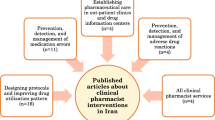Abstract
Background Pharmaceutical interventions by community and hospital pharmacists can improve medication safety and result in financial savings. Their effect has not been fully explored in Japan. Objective To evaluate the economic and safety contributions of various pharmaceutical interventions by community and hospital pharmacists in Japan. Setting Two hospitals and eight community pharmacies in Ehime Prefecture, Japan, in 2014–2015. Method Pharmacists entered data about pharmaceutical interventions via the internet, and the data were divided into 11 types of interventions. The economic impact was estimated based on the rate of avoidance of serious adverse drug reactions and the monetary cost of these reactions in the Japanese compensation system. The cost saving from adjusting prescriptions to take account of unused prescription drugs was calculated using drug prices from the national health insurance scheme. Main outcome measure The number of pharmaceutical interventions and their economic impact. Results The total cost savings from 500 to 509 pharmaceutical interventions by community and hospital pharmacists were US$207,126.6 and US$592,840, respectively. Community pharmacists mainly intervened to correct prescription errors. They also adjusted 135 prescriptions to take account of unused prescription drugs. This potentially improved patients’ adherence and contributed to effective use of medication. Pharmaceutical interventions by hospital pharmacists facilitated avoidance of 10 serious adverse drug reactions, and included 42 transvenous antimicrobial therapy interventions, 88 interventions in cancer chemotherapy, and 47 monitoring recommendations. Hospital pharmacists helped improve patients’ quality of life using more aggressive interventions besides correcting prescription errors. Over half of pharmaceutical interventions by community and hospital pharmacists contributed to avoidance of adverse drug reactions. Conclusion These results suggest the importance of pharmaceutical interventions by both community and hospital pharmacists in reducing increasing medical expenses and contributing to safety and effectiveness of medication. They also suggest that community and hospital pharmacists have different roles.


Similar content being viewed by others
References
Lazarou J, Pomeranz BH, Corey PN. Incidence of adverse drug reactions in hospitalized patients: a meta-analysis of prospective studies. JAMA. 1998;279:1200–5.
Miguel A, Azevedo LSF, Araújo M, Pereira AC. Frequency of adverse drug reactions in hospitalized patients: a systematic review and meta-analysis. Pharmacoepidemiol Drug Saf. 2012;21:1139–54.
Bond CA, Raehl CL. Adverse drug reactions in United States hospitals. Pharmacotherapy. 2006;26:601–8.
Perrone V, Conti V, Venegoni M, Scotto S, Degli Esposti L, Sangiorgi D, et al. Seriousness, preventability, and burden impact of reported adverse drug reactions in Lombardy emergency departments: a retrospective 2-year characterization. CEOR. 2014;6:505–14.
Zed PJ, Haughn C, Black KJ, Fitzpatrick EA, Ackroyd-Stolarz S, Murphy NG, et al. Medication-related emergency department visits and hospital admissions in pediatric patients: a qualitative systematic review. J Pediatr. 2013;163:477–83.
Wu C, Bell CM, Wodchis WP. Incidence and economic burden of adverse drug reactions among elderly patients in Ontario emergency departments: a retrospective study. Drug Saf. 2012;35:769–81.
Johnson JA, Bootman JL. Drug-related morbidity and mortality. A cost-of-illness model. Arch Intern Med. 1995;155:1949–56.
Ernst FR, Grizzle AJ. Drug-related morbidity and mortality: updating the cost-of-illness model. J Am Pharm Assoc (Wash). 2001;41:191–9.
Gertler SA, Coralic Z, López A, Stein JC, Sarkar U. Root cause analysis of ambulatory adverse drug events that present to the emergency department. J Patient Saf 2014; Epub ahead of print.
Zed PJ, Abu-Laban RB, Balen RM, Loewen PS, Hohl CM, Brubacher JR, et al. Incidence, severity and preventability of medication-related visits to the emergency department: a prospective study. CMAJ. 2008;178:1563–9.
Tasaka Y, Tanaka A, Ido K, Tanaka M, Araki H. Estimation of the economic impact associated with pharmaceutical interventions. Jpn J Pharm Health Care Sci. 2014;40:208–14.
Hamblin S, Rumbaugh K, Miller R. Prevention of adverse drug events and cost savings associated with PharmD interventions in an academic level I trauma center: an evidence-based approach. J Trauma Acute Care Surg. 2012;73:1484–90.
Ministry of Health, Labour and Welfare. 2011 Summary of Patients Survey [internet] [cited 2015 Dec 3]. http://www.mhlw.go.jp/english/database/db-hss/sps_2011.html.
Kaushal R, Bates DW, Landrigan C, McKenna KJ, Clapp MD, Federico F, et al. Medication errors and adverse drug events in pediatric inpatients. JAMA. 2001;285:2114–20.
Japan Pharmaceutical Association. Trend of pharmacy service under health insurance [internet] [cited 2015 Dec 3]. http://www.nichiyaku.or.jp/kokumin.php?p=11219.
Ministry of Health, Labour and Welfare. Trend survey of medical expense [internet] [cited 2015 Dec 3]. http://www.mhlw.go.jp/bunya/iryouhoken/database/zenpan/iryou_doukou.html.
Japan Pharmaceutical Association. Report of investigation research [internet] [cited 2015 Dec 3]. http://www.nichiyaku.or.jp/yakuzaishi.php?global_menu=&side_menu=%E5%90%84%E7%A8%AE%E8%B3%87%E6%96%99&contents=%E8%AA%BF%E6%9F%BB%E3%83%BB%E5%A0%B1%E5%91%8A%E6%9B%B8&id=341.
Briganti EM, Shaw JE, Chadban SJ, Zimmet PZ, Welborn TA, McNeil JJ, et al. Untreated hypertension among Australian adults: the 1999–2000 Australian Diabetes, Obesity and Lifestyle Study (AusDiab). Med J Aust. 2003;179:135–9.
Janus ED, Bunker SJ, Kilkkinen A, Mc Namara K, Philpot B, Tideman P, et al. Prevalence, detection and drug treatment of hypertension in a rural Australian population: the Greater Green Triangle Risk Factor Study 2004–2006. Intern Med J. 2008;38:879–86.
Burnier M. Medication adherence and persistence as the cornerstone of effective antihypertensive therapy. Am J Hypertens. 2006;19:1190–6.
Vrijens B, Vincze G, Kristanto P, Urquhart J, Burnier M. Adherence to prescribed antihypertensive drug treatments: longitudinal study of electronically compiled dosing histories. BMJ. 2008;336:1114–7.
Caro JJ, Salas M, Speckman JL, Raggio G, Jackson JD. Persistence with treatment for hypertension in actual practice. CMAJ. 1999;160:31–7.
Morgan SG, Yan L. Persistence with hypertension treatment among community-dwelling BC seniors. Can J Clin Pharmacol. 2004;11:e267–73.
McDonnell PJ, Jacobs MR. Hospital admissions resulting from preventable adverse drug reactions. Ann Pharmacother. 2002;36:1331–6.
Acknowledgments
We are grateful for the involvement of pharmacists at Shikoku Cancer Center, Ai Pharmacy, Ebisuya Pharmacy, Minara Pharmacy, Cosmo Pharmacy, Seihodo Pharmacy, Ehime Pharmacy, Magokoro Pharmacy, and Nanohana Pharmacy, who helped collect data for the study.
Funding
This study received funding from Ehime Prefecture.
Conflicts of interest
The authors declare that they have no conflict of interests.
Author information
Authors and Affiliations
Corresponding author
Rights and permissions
About this article
Cite this article
Tasaka, Y., Yasunaga, D., Tanaka, M. et al. Economic and safety benefits of pharmaceutical interventions by community and hospital pharmacists in Japan. Int J Clin Pharm 38, 321–329 (2016). https://doi.org/10.1007/s11096-015-0245-6
Received:
Accepted:
Published:
Issue Date:
DOI: https://doi.org/10.1007/s11096-015-0245-6




